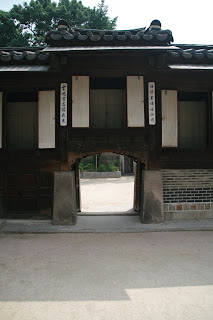
 This water . . . trough, sculpture, well . . . ? I liked it. It had a nice elegant simplicity to it.
This water . . . trough, sculpture, well . . . ? I liked it. It had a nice elegant simplicity to it. Apparently I was going where no Korean men had gone before (in the period) . . . lol.
Apparently I was going where no Korean men had gone before (in the period) . . . lol. I think this next pic is of an air intake port (or maybe for exhaust?) for the ondol floor heating system . . . cool.
I think this next pic is of an air intake port (or maybe for exhaust?) for the ondol floor heating system . . . cool. The most interesting thing about this 'women's only' area of the palace was . . . nothing. Nothing makes a bigger statement about the patriarchal nature of this period (and perhaps more interestingly the socio-cultural attitudes of today) then the lack of attention given to putting together exhibits showing the history and lives of the women who were living here . . . maybe there are other reasons, but I suspect my theory holds some validity.
The most interesting thing about this 'women's only' area of the palace was . . . nothing. Nothing makes a bigger statement about the patriarchal nature of this period (and perhaps more interestingly the socio-cultural attitudes of today) then the lack of attention given to putting together exhibits showing the history and lives of the women who were living here . . . maybe there are other reasons, but I suspect my theory holds some validity. Seriously . . . it's empty . . . how long has it been like this?
Seriously . . . it's empty . . . how long has it been like this? This little arch gateway was VERY funny to walk through . . . I felt like I was seven feet tall, lol.
This little arch gateway was VERY funny to walk through . . . I felt like I was seven feet tall, lol. I was trying to find some interesting shots to take when this group of kids walked into the frame . . .
I was trying to find some interesting shots to take when this group of kids walked into the frame . . . And then this little girl with a sunbrella walked by . . .
And then this little girl with a sunbrella walked by . . . Walking through this gate I re-entered the main courtyard of the palace . . . and took a shot looking back at where I had been . . .
Walking through this gate I re-entered the main courtyard of the palace . . . and took a shot looking back at where I had been . . . I then noticed an "Exhibition Hall" and wandered over to check it out.
I then noticed an "Exhibition Hall" and wandered over to check it out. The English on the sign outside the hall was the only English information available . . .
The English on the sign outside the hall was the only English information available . . .








 I realize that the palace is IN Korea, and it is a KOREAN historical site . . . but at the same time I struggle to reconcile this with the fact that Koreans want other countries to learn about Korean history and culture . . . and this is made nearly impossible by the lack of information available to tourists and other foreigners living and working inside Korea.
I realize that the palace is IN Korea, and it is a KOREAN historical site . . . but at the same time I struggle to reconcile this with the fact that Koreans want other countries to learn about Korean history and culture . . . and this is made nearly impossible by the lack of information available to tourists and other foreigners living and working inside Korea.I think that it is completely unrealistic to ask and expect foreign teachers who come to Korea for the average of a 1-2 year stay to learn enough Korean language skills to be able to read historical content that likely requires an intermediate to low-advanced level of ability . . . and I'm pretty sure that most tourists that come to Korea don't bone up on their Korean language ability beyond learning how to say hello, thank you, and the other survival Korean expressions required to travel around the country for a 1-2 week stay. . .
I really hope that one day this will improve so that the deep-seated desire for other countries to learn about Korean culture and history will actually have a chance of success.
J


































.jpg)

No comments:
Post a Comment